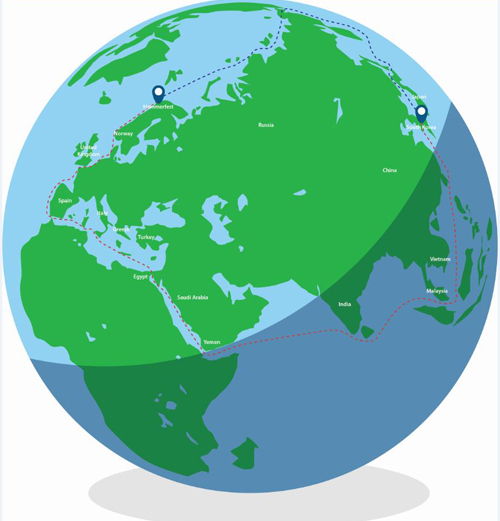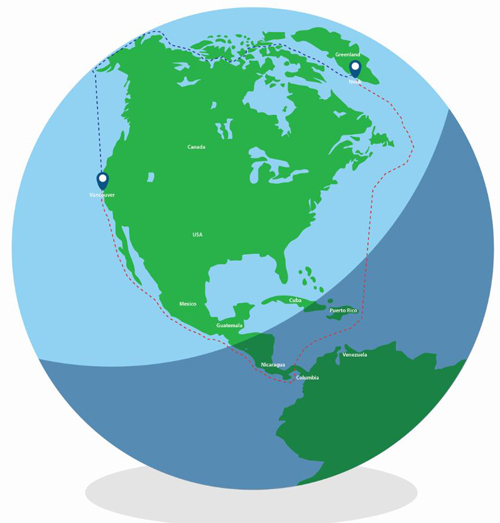Polar Regions
Climate change, vessel design, technological advances and the potential commercial advantages, have led to an increase in vessels transiting Polar Regions.
On the 31st July 2017 the LNG tanker Christophe de Margerie completed her first transit of the Northern Sea Route (NSR) from Norway to South Korea via Cape Zhelaniya and unassisted by any ice breaking tugs in only 19 days. The transit of the NSR from Cape Zhelaniya to Russia’s easternmost point of Chukotka was completed in just 6.5 days. It is one of the fastest transits of the NSR ever made and was completed with an average speed of between 11 to 16 knots. See Fig 1.
 |
 |
|
| Fig 1 | Fig 2 |
Route One: Hammerfest to South Korea using the NSR = 19 days at 14 knots.
Route Two: Hammerfest to South Korea using the Suez Canal = 31 days at 14 knots.
The MSV Nordica recently set a new record for the fastest transit of the Northwest Passage linking the Pacific and Atlantic Ocean through the Artic. The vessel completed the 6000 mile typically harsh environment transit in just 24 days. See Fig 2.
Route One: Vancouver to Nuuk using the Northwest Passage = 24 days at 11 knots.
Route Two: Vancouver to Nuuk using the Panama Canal = 31 days at 11 knots.
These examples demonstrate the increasing use of Polar Regions by vessels. The thickness and extent of the previously problematic ice is reducing, paving the way for longer periods of time when vessels can transit these areas, this coupled with advances in vessel design.
As well as cargo and research vessels there is a surge in tourism such as cruise ships in the Polar Regions, including Antarctic destinations. Some 40 passenger vessels a year visit Antarctica each carrying between 10 and 500 passengers. Voyages to Antarctica also have included larger passenger vessels (carrying from 500 to 3,000 guests), which conduct “cruise-by” or sightseeing cruises only, without landing.
NSR administrators believe that by 2025 the use of the NSR could have increased to 75 million tonnes.
There are many potential risks for vessels operating inside Polar Regions, such as:
- Temperature effects on essential machinery.
- Environmental effects on LSA and FFE equipment.
- Crew and Passenger exposure.
- Vessel navigation due to Satellite navigation issues in higher latitudes an scanty hydrographic information.
- Vessel communications in high latitudes.
- Crew Abandonment and Search and Rescue facilities.
Couple with the above safety issues is the potential impact on the sensitive marine environment from vessel pollution.
Norths Loss Prevention department has seen an increase in enquiries from Members regarding vessels trading inside the Polar Regions.
With the increase in Polar transits expected to continue to rise, the IMO have published the Polar Code which came into force in January 2017. The Code purpose is primarily to ensure that ships and their owners are prepared for the increased risk of operating in the Polar Regions with regard to crew safety and environmental protection.
Before considering operating in the Polar Region, ship owners and operators should ensure that they both understand and comply with the Polar Code requirements.
Further Information
North’s Loss Prevention Team has published a new Loss Prevention briefing on the Polar code which can be read here.

 , you have now set your site language to English. If you'd like to change your language preference again, simply click on one of the other flags.
, you have now set your site language to English. If you'd like to change your language preference again, simply click on one of the other flags. を選択して頂くと、言語設定が日本語に切り替わります。設定変更後は以下の機能が利用可能です。
を選択して頂くと、言語設定が日本語に切り替わります。設定変更後は以下の機能が利用可能です。
 ,可将网站语言设置为中文。这能帮助您:
,可将网站语言设置为中文。这能帮助您:


